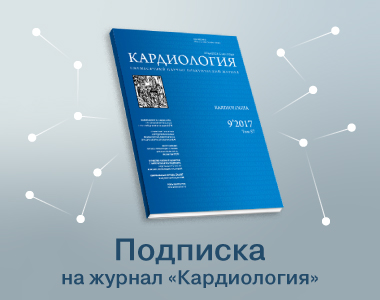Влияние кальцифицированной бляшки и наличия стента в коронарной артерии на тяжесть заболевания и выживаемость пациентов с COVID-19: исследование модели дерева решений
https://doi.org/10.18087/cardio.2023.7.n2251
Аннотация
Цель. Целью исследования явилось изучение взаимосвязи между наличием кальцифицированных бляшек и стентов в коронарных артериях с данными компьютерной томографии (КТ) грудной клетки (Chest Computed Tomography Severity Score - CT-SS), и показателями смертности у пациентов с COVID-19.
Материалы и методы. Был проведен одноцентровый ретроспективный анализ 492 пациентов (≥18 лет), госпитализированных в период с марта по июнь 2020 года. Все включенные в исследование пациенты имели положительный результат теста ОТ-ПЦР на COVID-19. Наличие коронарной кальцифицированной бляшки и/или стента, проволоки после стернотомии и протезированного сердечного клапана оценивалось на исходной КТ грудной клетки без контрастирования. Кроме того, по данным КТ грудной клетки рассчитывали кардиоторакальный индекс (КТИ). Данные были проанализированы с использованием одномерного и многомерного анализов и древовидного анализа автоматического обнаружения взаимодействий по критерию хи-квадрат (CHAID), который был разработан как прогностическая модель для выживания пациентов с COVID-19 в соответствии с результатами КТ грудной клетки.
Результаты. Среднее количество баллов по шкале CT-SS у пациентов с коронарной бляшкой составило 11,88±7,88. Была обнаружена статистически значимая связь между величиной CT-SS и наличием коронарной кальцифицированной бляшки (p<0,001). Статистической разницы между количеством баллов по шкале CT-SS и коронарным стентированием обнаружено не было (р=0,296). По данным многофакторного анализа, пожилой возраст был связан с более высокой вероятностью (в 1,69 раза (p< 0,001)) наличия коронарных кальцифицированных бляшек, с более высоким значением CT-SS (в 1,943 раза (p=0,034)) и более высоким (в 1,038 раза (p=0,042)) риском развития летального исхода. При проведении CHAID анализа самый высокий уровень смертности наблюдался у пациентов с коронарной бляшкой и КТИ>0,57.
Вывод. Наличие кальцифицированных бляшек в коронарных артериях и кардиомегалия были ассоциированы с высоким риском тяжелого течения и смертности у пациентов с COVID-19, и могут использоваться при прогнозировании выживаемости пациентов.
Об авторах
Бурджу АкманТурция
доцент, кафедра радиологии, медицинский факультет,
Амасья
Ахмет Туран Кая
Турция
MD, кафедра радиологии, медицинский факультет,
Амасья
Список литературы
1. Shi Y, Wang G, Cai X, Deng J, Zheng L, Zhu H et al. An overview of COVID-19. Journal of Zhejiang University-SCIENCE B. 2020;21(5):343–60. DOI: 10.1631/jzus.B2000083
2. Bhandari S, Rankawat G, Bagarhatta M, Singh A, Singh A, Gupta V et al. Clinico-Radiological Evaluation and Correlation of CT Chest Images with Progress of Disease in COVID-19 Patients. The Journal of the Association of Physicians of India. 2020;68(7):34–42. PMID: 32602679
3. Huang C, Wang Y, Li X, Ren L, Zhao J, Hu Y et al. Clinical features of patients infected with 2019 novel coronavirus in Wuhan, China. The Lancet. 2020;395(10223):497–506. DOI: 10.1016/S0140-6736(20)30183-5
4. Lian J, Cai H, Hao S, Jin X, Zhang X, Zheng L et al. Comparison of epidemiological and clinical characteristics of COVID-19 patients with and without Wuhan exposure. Journal of Zhejiang University-SCIENCE B. 2020;21(5):369–77. DOI: 10.1631/jzus.B2000112
5. Sun D, Li X, Guo D, Wu L, Chen T, Fang Z et al. CT Quantitative Analysis and Its Relationship with Clinical Features for Assessing the Severity of Patients with COVID-19. Korean Journal of Radiology. 2020;21(7):859–68. DOI: 10.3348/kjr.2020.0293
6. Li B, Yang J, Zhao F, Zhi L, Wang X, Liu L et al. Prevalence and impact of cardiovascular metabolic diseases on COVID-19 in China. Clinical Research in Cardiology. 2020;109(5):531–8. DOI: 10.1007/s00392-020-01626-9
7. Wang D, Hu B, Hu C, Zhu F, Liu X, Zhang J et al. Clinical Characteristics of 138 Hospitalized Patients With 2019 Novel Coronavirus–Infected Pneumonia in Wuhan, China. JAMA. 2020;323(11):1061–9. DOI: 10.1001/jama.2020.1585
8. Wu Z, McGoogan JM. Characteristics of and Important Lessons From the Coronavirus Disease 2019 (COVID-19) Outbreak in China: Summary of a Report of 72 314 Cases From the Chinese Center for Disease Control and Prevention. JAMA. 2020;323(13):1239–42. DOI: 10.1001/jama.2020.2648
9. Cereda A, Toselli M, Palmisano A, Vignale D, Khokhar A, Campo G et al. Coronary calcium score as a predictor of outcomes in the hypertensive Covid-19 population: results from the Italian (S) Core-Covid-19 Registry. Hypertension Research. 2022;45(2):333–43. DOI: 10.1038/s41440-021-00798-9
10. Qazi AH, Zallaghi F, Torres-Acosta N, Thompson RC, O’Keefe JH. Computed Tomography for Coronary Artery Calcification Scoring: Mammogram for the Heart. Progress in Cardiovascular Diseases. 2016;58(5):529–36. DOI: 10.1016/j.pcad.2016.01.007
11. Dillinger JG, Benmessaoud FA, Pezel T, Voicu S, Sideris G, Chergui N et al. Coronary Artery Calcification and Complications in Patients With COVID-19. JACC: Cardiovascular Imaging. 2020;13(11):2468–70. DOI: 10.1016/j.jcmg.2020.07.004
12. Nair AV, Kumar D, Yadav SK, Nepal P, Jacob B, Al-Heidous M. Utility of visual coronary artery calcification on non-cardiac gated thoracic CT in predicting clinical severity and outcome in COVID-19. Clinical Imaging. 2021;74:123–30. DOI: 10.1016/j.clinimag.2021.01.015
13. Pan F, Ye T, Sun P, Gui S, Liang B, Li L et al. Time Course of Lung Changes at Chest CT during Recovery from Coronavirus Disease 2019 (COVID-19). Radiology. 2020;295(3):715–21. DOI: 10.1148/radiol.2020200370
14. Prokop M, van Everdingen W, van Rees Vellinga T, Quarles van Ufford H, Stöger L, Beenen L et al. CORADS: A Categorical CT Assessment Scheme for Patients Suspected of Having COVID-19 – Definition and Evaluation. Radiolgy. 2020;296(2):E97–104. DOI: 10.1148/radiol.2020201473
15. Eslami V, Abrishami A, Zarei E, Khalili N, Baharvand Z, Sanei-Taheri M. The Association of CT-measured Cardiac Indices with Lung Involvement and Clinical Outcome in Patients with COVID-19. Academic Radiology. 2021;28(1):8–17. DOI: 10.1016/j.acra.2020.09.012
16. Jotterand M, Faouzi M, Dédouit F, Michaud K. New formula for cardiothoracic ratio for the diagnosis of cardiomegaly on post-mortem CT. International Journal of Legal Medicine. 2020;134(2):663–7. DOI: 10.1007/s00414-019-02113-1
17. Menard S. Applied Logistic Regression Analysis. - California, USA: SAGE Publications, Inc.;2002. - 128 p. ISBN 978-0-7619-2208-7
18. Hosmer DW, Lemeshow S, Sturdivant RX. Applied logistic regression. -Hoboken, New Jersey: Wiley;2013. - 528 p. ISBN 978-1-118-54835-6
19. Che D, Liu Q, Rasheed K, Tao X. Decision Tree and Ensemble Learning Algorithms with Their Applications in Bioinformatics. P. 191-199. DOI: 10.1007/978-1-4419-7046-6_19. In: Software Tools and Algorithms for Biological Systems. T. 696. Arabnia HR, Tran Q-N, editors -New York, NY: Springer New York;2011.
20. Budoff MJ, Shaw LJ, Liu ST, Weinstein SR, Tseng PH, Flores FR et al. Long-Term Prognosis Associated With Coronary Calcification. Journal of the American College of Cardiology. 2007;49(18):1860–70. DOI: 10.1016/j.jacc.2006.10.079
21. Greenland P. Coronary Artery Calcium Score Combined With Framingham Score for Risk Prediction in Asymptomatic Individuals. JAMA. 2004;291(2):210–5. DOI: 10.1001/jama.291.2.210
22. Gupta VA, Sousa M, Kraitman N, Annabathula R, Vsevolozhskaya O, Leung SW et al. Coronary artery calcification predicts cardiovascular complications after sepsis. Journal of Critical Care. 2018;44:261–6. DOI: 10.1016/j.jcrc.2017.11.038
23. Knapper JT, Khosa F, Blaha MJ, Lebeis TA, Kay J, Sandesara PB et al. Coronary calcium scoring for long-term mortality prediction in patients with and without a family history of coronary disease. Heart. 2016;102(3):204–8. DOI: 10.1136/heartjnl-2015-308429
24. Nasir K, Rubin J, Blaha MJ, Shaw LJ, Blankstein R, Rivera JJ et al. Interplay of Coronary Artery Calcification and Traditional Risk Factors for the Prediction of All-Cause Mortality in Asymptomatic Individuals. Circulation: Cardiovascular Imaging. 2012;5(4):467–73. DOI: 10.1161/CIRCIMAGING.111.964528
25. Zheng Y-Y, Ma Y-T, Zhang J-Y, Xie X. COVID-19 and the cardiovascular system. Nature Reviews Cardiology. 2020;17(5):259–60. DOI: 10.1038/s41569-020-0360-5
26. Guan W, Ni Z, Hu Y, Liang W, Ou C, He J et al. Clinical Characteristics of Coronavirus Disease 2019 in China. New England Journal of Medicine. 2020;382(18):1708–20. DOI: 10.1056/NEJMoa2002032
27. Ruan Q, Yang K, Wang W, Jiang L, Song J. Clinical predictors of mortality due to COVID-19 based on an analysis of data of 150 patients from Wuhan, China. Intensive Care Medicine. 2020;46(5):846–8. DOI: 10.1007/s00134-020-05991-x
28. Zhou F, Yu T, Du R, Fan G, Liu Y, Liu Z et al. Clinical course and risk factors for mortality of adult inpatients with COVID-19 in Wuhan, China: a retrospective cohort study. The Lancet. 2020;395(10229):1054–62. DOI: 10.1016/S0140-6736(20)30566-3
29. Shi S, Qin M, Shen B, Cai Y, Liu T, Yang F et al. Association of Cardiac Injury With Mortality in Hospitalized Patients With COVID-19 in Wuhan, China. JAMA Cardiology. 2020;5(7):802–10. DOI: 10.1001/jamacardio.2020.0950
30. Wei PF. Diagnosis and Treatment Protocol for Novel Coronavirus Pneumonia (Trial Version 7). Chinese Medical Journal. 2020;133(9):1087–95. DOI: 10.1097/CM9.0000000000000819
31. Gupta YS, Finkelstein M, Manna S, Toussie D, Bernheim A, Little BP et al. Coronary artery calcification in COVID-19 patients: an imaging biomarker for adverse clinical outcomes. Clinical Imaging. 2021;77:1– 8. DOI: 10.1016/j.clinimag.2021.02.016
32. Pugliese F, Cademartiri F, van Mieghem C, Meijboom WB, Malagutti P, Mollet NRA et al. Multidetector CT for Visualization of Coronary Stents. RadioGraphics. 2006;26(3):887–904. DOI: 10.1148/rg.263055182
33. Wells JM, Morrison JB, Bhatt SP, Nath H, Dransfield MT. Pulmonary Artery Enlargement Is Associated With Cardiac Injury During Severe Exacerbations of COPD. Chest. 2016;149(5):1197–204. DOI: 10.1378/chest.15-1504
34. Zouk AN, Gulati S, Xing D, Wille KM, Rowe SM, Wells JM. Pulmonary artery enlargement is associated with pulmonary hypertension and decreased survival in severe cystic fibrosis: A cohort study. PLOS ONE. 2020;15(2):e0229173. DOI: 10.1371/journal.pone.0229173
35. Jacobs PC, Gondrie MJA, van der Graaf Y, de Koning HJ, Isgum I, van Ginneken B et al. Coronary Artery Calcium Can Predict All-Cause Mortality and Cardiovascular Events on Low-Dose CT Screening for Lung Cancer. American Journal of Roentgenology. 2012;198(3):505–11. DOI: 10.2214/AJR.10.5577
36. Pelandré GL, Sanches NMP, Nacif MS, Marchiori E. Detection of coronary artery calcification with nontriggered computed tomography of the chest. Radiologia Brasileira. 2018;51(1):8–12. DOI: 10.1590/0100-3984.2016.0181
37. Shemesh J, Henschke CI, Shaham D, Yip R, Farooqi AO, Cham MD et al. Ordinal Scoring of Coronary Artery Calcifications on Low-Dose CT Scans of the Chest is Predictive of Death from Cardiovascular Disease. Radiology. 2010;257(2):541–8. DOI: 10.1148/radiol.10100383
38. Erbel R, Möhlenkamp S, Moebus S, Schmermund A, Lehmann N, Stang A et al. Coronary Risk Stratification, Discrimination, and Reclassification Improvement Based on Quantification of Subclinical Coronary Atherosclerosis. Journal of the American College of Cardiology. 2010;56(17):1397–406. DOI: 10.1016/j.jacc.2010.06.030
39. Esposito A, Palmisano A, Toselli M, Vignale D, Cereda A, Rancoita PMV et al. Chest CT–derived pulmonary artery enlargement at the admission predicts overall survival in COVID-19 patients: insight from 1461 consecutive patients in Italy. European Radiology. 2021;31(6):4031–41. DOI: 10.1007/s00330-020-07622-x
Дополнительные файлы
Рецензия
Для цитирования:
Акман Б., Кая А.Т. Влияние кальцифицированной бляшки и наличия стента в коронарной артерии на тяжесть заболевания и выживаемость пациентов с COVID-19: исследование модели дерева решений. Кардиология. 2023;63(7):54-61. https://doi.org/10.18087/cardio.2023.7.n2251
For citation:
Akman B., Kaya A.T. Effects of coronary artery calcified plaque and stent on severity and survival of COVID-19 patients: a decision tree model study. Kardiologiia. 2023;63(7):54-61. https://doi.org/10.18087/cardio.2023.7.n2251

















